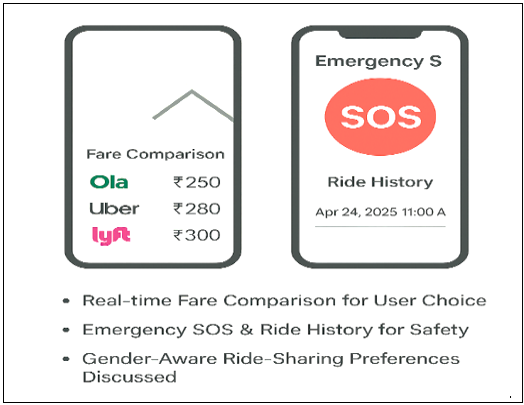Safe Rides, Fair Prices: A Comprehensive Analysis of India’s Ride-Hailing Sector
DOI:
https://doi.org/10.26438/ijsrcse.v13i3.630Keywords:
Ride-Hailing, Fare Transparency, Competitive Pricing, India’s Taxi Market, Security Measures, Customer Satisfaction, Gender-Based Services, Mobile Application, Urban Mobility, Ride Safety, Surge PricingAbstract
The taxi aggregator industry in India, driven by companies such as Ola and Uber, has massively disrupted the state of urban commute via affordable and tech-enabled transport. As competition escalates, operators are positioning on price, user experience, and additional safety features. This paper studies different pricing policies and their impacts on customer behavior and the market. The roadmap includes a focus on things like fare transparency, driver quality, response times, and app performance, as well as safety features designed with the users in mind. The paper also looks at gender-sensitive transportation options, including women-run cabs for women passengers that not only increase safety but also include women in the economic process. One of the key contributions of this work is the conceptualization, implementation, and deployment of CabEase, a mobile app that provides real-time fare comparisons, integrated SOS alerts, ride tracking, and a gender-aware ride-matching process. The app uses location-based services and usability to increase the trust and decision-making process of commuters. By the survey data, experimental comparisons, and feature validation, the research sheds light on customer satisfaction and operational improvements in the Indian taxi aggregator ecosystem. The results contribute to a better understanding of the design of shared, secure, and fair ride booking services in response to changing urban dynamics.
References
V. K. Bishnoi and R. Bhardwaj, “Cab Aggregators in India: A Case Study of Ola and Uber,” Int. J. Transport Manag., Vol.3, No.2, pp.45–50, 2021.
A. Chivukyla and A. K. Deshmukh, “Pricing Strategy of Cab Aggregators in India,” J. Revenue Pricing Manag., Vol.19, No.4, pp.305–312, 2020.
A. Hanif and K. Sagar, “Safety Initiatives in the Taxi Industry: Lessons from Meru Cabs in India,” J. Transp. Saf. Secur., Vol.9, No.3, pp.45–57, 2016.
E. N. Horsu and S. T. Yeboah, “Customer Satisfaction in Taxi Services: A Focus on Driver Behavior,” Int. J. Serv. Sci. Manag., Vol.7, No.2, pp.87–94, 2015.
V. Jalan, V. Jain, V. Kohli, V. Mehta and W. Agha, “Application of Operations Research in Cab Aggregator Routine Assignments,” Int. J. Oper. Res., Vol.4, No.1, pp.21–29, 2020.
M. Kavita, S. Rao and T. Prasad, “The Role of Mobile Wallets in Transforming Customer Experiences in the Taxi Industry,” J. Digit. Payments, Vol.3, No.5, pp.67–79, 2016.
A. K. Panigrahi, S. Shahi and A. S. Rathore, “The Success Story of a Startup: A Case Study of Ola Cabs,” Int. J. Entrepreneurship Res., Vol.5, No.1, pp.55–63, 2019.
R. Pallavi, “Impact of Technology on Urban Mobility: The Rise of Platform-Based Aggregator Taxi Services,” Urban Mobil. J., Vol.12, No.4, pp.123–138, 2018.
N. M. Rani, S. D. Chatterjee, S. Mondal and S. Lenka, “Consumer Preference Regarding Cab Aggregator Services in Bangalore,” J. Consum. Res. Stud., Vol.6, No.2, pp.112–121, 2020.
A. R. H. Rohit, “Legal Implications of Surge Pricing in India: A Consumer Fairness Perspective,” Indian J. Law Econ., Vol.6, No.2, pp.201–220, 2017.
A. I. Samwell, “Kya Bakregator Platform Research Paper,” J. Platform Econ., Vol.4, No.3, pp.58–65, 2021.
S. K. K. Sarvepalli and A. M. Prakash, “Cab Aggregation Industry in India: An Overview, Current Scenario, Issues, and Possibilities for Consolidation,” J. Urban Transp. Res., Vol.5, No.2, pp.77–90, 2021.
S. Shukla, M. Patil and A. Sharma, “Pricing Innovations in the Taxi Aggregator Industry: The Case of Ola and Uber,” J. Pricing Strategy Res., Vol.10, No.1, pp.32–48, 2017.
T. Selvi, “For Women, By Women: A Case Study on Taxi Service Aggregators’ Initiative to Empower Women in India,” J. Gender Stud., Vol.9, No.3, pp.66–74, 2022.
S. Tirumal and D. Sobini, “A Study on the Impact of Cab Aggregators Concerning Chennai City,” Indian J. Urban Mobil. Stud., Vol.7, No.2, pp.104–115, 2020.
G. Venkatesh and G. Easaw, “Measuring the Performance of Taxi Aggregator Service Supply Chain,” J. Logist. Transp. Stud., Vol.8, No.4, pp.212–223, 2021.
T. W. Martens and A. Hillbert, “Conceptual Model and Operational Processes of Customer Value-Based Revenue Management in Transport and Logistics,” Int. J. Transport Manag., Vol.9, No.3, pp.140–150, 2020.
S. Patil and A. Patil, “Comparative Study of Online Cab Booking Services Using Data Mining,” Int. J. Sci. Res. Comput. Sci. Eng. Inf. Technol., Vol.3, No.3, pp.1080–1084, 2018.
P. Sawant and S. More, “Cab Aggregators Market: Analysis of Customer Satisfaction and Market Share,” Int. J. Sci. Res. Comput. Sci. Eng., Vol.7, No.6, pp.150–155, 2019.

Downloads
Published
How to Cite
Issue
Section
License
Copyright (c) 2025 Priti Kushwaha, Nihira Khare, Dr. Pankaj Kumar, Ratan Rajan Srivastava

This work is licensed under a Creative Commons Attribution 4.0 International License.
Authors contributing to this journal agree to publish their articles under the Creative Commons Attribution 4.0 International License, allowing third parties to share their work (copy, distribute, transmit) and to adapt it, under the condition that the authors are given credit and that in the event of reuse or distribution, the terms of this license are made clear.






